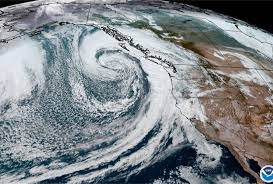By Erin Woolley
Between December and mid-March, we’ve had an onslaught of eleven atmospheric rivers to California, which claimed several lives, and caused severe flooding, power outages, damage to infrastructure, and threatened the safety of several communities.

NOAA Atmospheric River off CA Coast
After two of the driest years on record, the storms provided some reprieve to our water supply issues, but the overall impact of these storms should not be overestimated. Snowpack is above average in the Northern, Central, and Southern Sierra, and reservoir conditions have improved. However, most reservoirs are not full, and many remain below the historic average for this time of year. Whether the snowpack will stay or melt away before April depends on weather conditions over the next few months. Most importantly, the vast majority of California is still experiencing either moderate or severe drought conditions as of this week.
The series of storms highlights an urgent need for California to update and maintain its existing water infrastructure to protect public safety and ensure resiliency as severe weather events become more common. As the state considers investments, we must ensure that the solutions are well-suited to the entirety of the problem we face: flooding, aridification, ecosystem needs, and above all: improved water management and decision-making. Decades of mismanaged groundwater aquifers and unsustainable surface water diversions cannot be resolved by a single month of extreme rain.
Some have opined that California should actually increase water diversions so as to not waste water by letting it flow into the ocean. But increasing already unsustainable water diversions from the Sacramento River is unreliable and would exacerbate decades of ecosystem and community decline in the SF Bay Delta, and would provide comparatively minor water supplies under even the most optimistic regulatory scenarios. DWR recently estimated that the Delta Tunnel could have captured an additional 202,000 AF of water during the January storms. Sites Reservoir reportedly could have diverted and stored 382,000 AF of water during January and February, under forecasted conditions. These two projects will cost ratepayers billions of dollars and take years of construction before any water could actually be delivered.
California needs solutions that will address our water resiliency needs in the long term. Urban stormwater capture in a dry year could add 580,000 acre-feet (AF) of water. That number jumps to 3 million AF in wet years. Combined with improving groundwater storage and management, this has the potential to respond to flood conditions and store water for use in naturally occurring aquifers for use in dry periods. Agricultural and urban water efficiency measures and urban water recycling could contribute to additional savings and a new supply of several million AF annually.
Atmospheric Rivers cannot sustain business-as-usual water diversions while California’s climate becomes hotter, drier, and more susceptible to long-term drought. We must adapt to a new climate with solutions that provide local and regional water resiliency, not perpetuate unsustainable systems.
View Understanding of Atmospheric Rivers by F. Martin Ralph, Director of the Center for Western Weather and Water Extremes at UC San Diego/Scripps Institution for Oceanography on YouTube HERE.
Additional Reading: Better Atmospheric River Forecasts Are Giving Emergency Planners More Time to Prepare for Flooding: Knowing when torrents of rain will strike can save property and lives
Erin is the Water Policy advocate for Sierra Club CA
